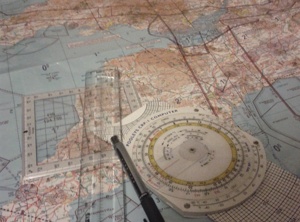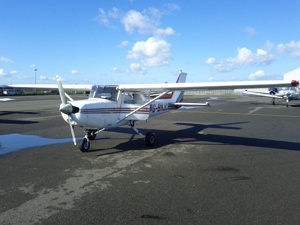Learning to fly is an odd experience. Around 20 hours in, when your instructor steps out of the plane and sends you solo for the first time, you realise that you're now in sole control of a plane - with all the benefits and dangers that that brings. It's both thrilling and slightly terrifying.
The start of my flying bug was thanks to my family. They bought me a trial lesson for my birthday last year. I did it, enjoyed it, and then left it for a few months. Finally, I set the money aside to learn - the majority of my savings - found a flying school that was easy to get to from my flat, and signed up.
That was late last year. Thanks to some typically British bad weather, the Olympics, and only flying one day a week, I'm only now coming to the end of my course - but it's been a good year.
For those unfamiliar with the requirements of a private pilot's license, there are a few basic rules you have to meet. The main ones are the times - at least 45 hours flying (including when you're with an instructor), and at least 10 hours of solo flying.
Then, of course, there's the test. Or rather, all ten of them - seven written exams, a spoken communications exam, the qualifying cross-country and the final skills test.
The exams are comparatively easy - provided you read and digest the seven textbooks (see below for how sizable they are) and do a few practice exams, they're not too bad - and, after all, they're multiple-choice, which is mostly a help but sometimes a hindrance.
The two meatiest things are the qualifying cross-country flight, and the skills test. The skills test is the flying version of your standard driving test - the examiner comes flying with you, and asks you to perform a series of manoeuvres and operations to verify you can plan, fly and carry passengers safely.
However, the qualifying cross-country is a different beast. One of the skills needed to be a good pilot is being able to navigate long distances without getting lost, and being able to land well at airports other than your own. Doing this with the examiner along would take an entire day, and they'd have to sit next to you in silence for several of the hour-long navigation legs - not really pleasant for either party.
Instead, students complete a 'cross-country' flight of three legs. It has to be more than 150 nautical miles in total, you have to land at two aerodromes other than your own, and one of those has to be a controlled airport (meaning that there's an ATC unit directing all the planes and issuing proper clearances). It doesn't actually have to be across the country - in fact, they always end at the same place they began.
My first attempt at a cross-country flight was last week, but unfortunately some uncertain weather called it off. Fortunately, this week the weather was good, the winds were within limits, and so I set off on my journey.
My route took me down to Eastbourne, then along the coast to Lydd, which was my first stop (and the controlled airport). Fortunately, nothing much happens along the route, though on the radio I overhear someone straying into Heathrow's airspace and the controller getting a little frantic as they make them turn around.
After a pretty good landing, I park up outside the terminal (A terminal? Luxury!), got the tanker to fill the plane up (I usually have to do that myself from a pump), and had a bite to eat.
A check of the plane and a takeoff later, and I was off inland, going almost as far as Tunbridge Wells before turning north, going over the Thames and catching another look at London (looking lovely from the air) before heading off into Essex to Earls Colne, my second stop.
Earls Colne is a bit smaller than Lydd. By this, I mean it has a runway which is only about as wide as a suburban road, a small building with a reception desk and a burger van outside for food. However, they're a lovely lot, and while I wasn't in the mood for some burger-based delights I'm sure I'll give in next time I visit.
Form signed, landing fee paid, and it's a relatively short journey back to Stapleford, my home base. I slightly mess up my join of the circuit - coming in around 200 feet too high as I'm trying to avoid another aircraft. Fortunately, they're a lot quicker than I am and are soon far ahead, giving me plenty of space to get everything in order, do my final checks, and land the plane.
Fortunately, there's no messages from the other airports saying I failed the departure (I've already got their signatures on a form for my arrival and taxiing), and so I'm done!
I have to fill out yet more paperwork - a technical log and my logbook - in addition to the three forms I signed before I left. I finish off the day by taking my last written exam; ten minutes later, and I'm finished. It's always nice to leave an easy exam till last, and even nicer to know that I've not got worse at exams since I left university.
Not much lies ahead now - a couple more lessons, one of them a mock test, and then I'll be ready for the real thing. Who knows, in a month or two I might actually be a qualified pilot. What an odd feeling.



